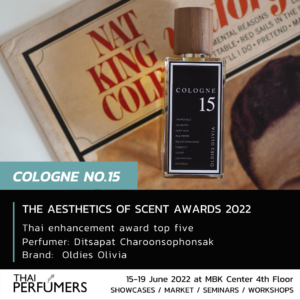เคยสงสัยกันไหมว่าด้านหลังกล่องน้ำหอมที่เราไปซื้อตามเคาท์เตอร์แบรนด์ มักจะมีการบอกส่วนผสม (Ingredients) แต่จะอ่านอย่างไรก็ไม่เข้าใจเพราะมีแต่ชื่อสารเคมีเต็มไปหมด….แล้วนั่นคือส่วนผสมทั้งหมดของน้ำหอมกลิ่นนั้นจริงๆ หรือ? เราจะมาสรุปให้ทุกคนเข้าใจกัน
ก่อนอื่นเลยสิ่งที่อยู่บนฉลาก Ingredients นั้นคือ Allergens in cosmetic products หรือ สารที่ทำให้เกิดภูมิแพ้ในเครื่องสำอาง
สารก่อภูมิแพ้คืออะไร?
แม้ว่าคำว่า “สารก่อภูมิแพ้” จะไม่ปรากฏในระเบียบข้อบังคับด้านเครื่องสำอางของสหภาพยุโรป แต่สาร 26 ชนิดที่ระบุไว้ในภาคผนวกที่ 3 นั้น มีความจำเป็นต้องระบุชื่อสารนั้นๆ ให้ชัดเจนบนกล่องหรือผลิตภัณฑ์ The paragraph 49 of Regulation 1223/2009 ระบุไว้ว่า
“A number of substances have been identified by the SCCS as likely to cause allergic reactions and it will be necessary to restrict their use and/or impose certain conditions concerning them. In order to ensure that consumers are adequately informed, the presence of these substances should be mentioned in the list of ingredients and consumers’ attention should be drawn to the presence of these ingredients. This information should improve the diagnosis of contact allergies among consumers and should enable them to avoid the use of cosmetic products which they do not tolerate. For substances which are likely to cause allergy to a significant part of the population, other restrictive measures such as a ban or a restriction of concentration should be considered.”
SCCS ระบุสารจำนวนหนึ่งว่า น่าจะทำให้เกิดอาการแพ้และจำเป็นต้องจำกัดการใช้สารเหล่านั้น และ/หรือ กำหนดเงื่อนไขบางประการเกี่ยวกับสารเหล่านี้ เพื่อให้แน่ใจว่าผู้บริโภคได้รับข้อมูลอย่างเพียงพอ ควรกล่าวถึงการมีอยู่ของสารเหล่านี้ในรายการส่วนผสมและควรดึงความสนใจของผู้บริโภคไปที่การมีอยู่ของส่วนผสมเหล่านี้ ข้อมูลนี้ควรปรับปรุงการวินิจฉัยการแพ้จากการสัมผัสของผู้บริโภค และควรช่วยให้พวกเขาหลีกเลี่ยงการใช้ผลิตภัณฑ์เครื่องสำอางที่พวกเขาไม่แพ้ สำหรับสารที่มีแนวโน้มที่จะก่อให้เกิดการแพ้ต่อประชากรส่วนใหญ่ ควรพิจารณามาตรการจำกัดอื่นๆ เช่น การห้ามใช้หรือการจำกัดความเข้มข้น
โดยปกติ สารก่อภูมิแพ้ที่ก่อให้เกิดภูมิแพ้มากที่สุดจะอยู่ในน้ำหอม โดย คณะกรรมการวิทยาศาสตร์ด้านความปลอดภัยของผู้บริโภค (SCCS) ได้ตีพิมพ์เอกสารข้อเท็จจริงซึ่งอธิบายว่า 1 ถึง 3% ของประชากรยุโรปมีอาการแพ้เนื่องจากส่วนผสมของน้ำหอม ในความเห็นนี้ SCCS ก้าวไปไกลกว่ากฎระเบียบที่แท้จริง และได้ระบุสารเคมี 30 ชนิด นอกเหนือจากสารสกัดจากธรรมชาติ 26 ชนิดที่ระบุไว้ในระเบียบเครื่องสำอาง คาดว่าจะมีการปรับปรุงสำหรับปี 2559-2560 และสารกว่า 90 รายการจะได้รับการควบคุมอย่างเข้มงวดยิ่งขึ้น
จุดมุ่งหมายของการจำกัดสารในน้ำหอมบางชนิดคืออะไร?
มีวัตถุประสงค์เพื่อปกป้องผู้บริโภคที่อาจแพ้โดยให้ข้อมูลที่เพียงพอในเวลาที่ซื้อผลิตภัณฑ์ ผู้บริโภคควรทราบทันทีว่าเครื่องสำอางมีสารก่อภูมิแพ้หรือไม่ เพื่อหลีกเลี่ยงอาการภูมิแพ้อาหารแฝง
ข้อมูลควรมีความชัดเจนและเข้าถึงได้ง่ายสำหรับผู้บริโภคและบุคลากรทางการแพทย์ ต้องใช้การติดฉลาก (ข้อกำหนดบังคับ) แต่ควรใช้วิธีการทางดิจิทัลที่ไม่ระบุตัวตน เช่น การให้ข้อมูลสารก่อภูมิแพ้ในเว็บไซต์
วิธีการสื่อสารกับผู้บริโภคจะต้องใช้งานได้จริง สามารถจัดการได้ง่ายโดยอุตสาหกรรม รวมถึงการปรับให้เข้ากับข้อกำหนดด้านกฎระเบียบเพิ่มเติมในระยะยาว
COSMED สมาคมการค้าฝรั่งเศสเสนอแนวทางไฮบริด:
- การติดฉลากสารก่อภูมิแพ้ปัจจุบัน 26 รายการบนผลิตภัณฑ์
- รูปสัญลักษณ์บนฉลากเพื่ออ้างถึงลิงก์ของเว็บซึ่งมีข้อมูลโดยละเอียด: การมีอยู่ของสารก่อภูมิแพ้อื่นๆ สภาพการใช้งานและการป้องกัน
รายชื่อสารก่อภูมิแพ้ 26 ชนิด
| INCI Name | CAS Number | Origin | Can be found in |
| Alpha-Isomethyl ionone / Gamma-Methyl Ionone | 127-51-5 | Synthetic | N/A |
| Amyl cinnamal / Amyl Cinnamic Aldehyde | 122-40-7 | Synthetic | N/A |
| Amylcinnamyl alcohol / Amyl Cinnamic Alcohol | 101-85-9 | Synthetic | N/A |
| Anise alcohol / Anisyl Alcohol | 105-13-5 | Synthetic or Natural | Honey, essential oils of Anise, Tomatoes, Tahiti Vanilla |
| Benzyl alcohol | 100-51-6 | Synthetic or Natural | Peru Balsam, Tolu Balsam, Essential oils of Jasmin, Apricot, Almond, Apple, Asparagus, Banana, Black Currant, Blackberry |
| Benzyl benzoate | 120-51-4 | Synthetic or Natural | Peru Balsam, Tolu Balsam, Essential oils of Jasmin, Ylang-Ylang |
| Benzyl cinnamate | 103-41-3 | Synthetic or Natural | Peru Balsam, Tolu Balsam, Copahu |
| Benzyl salicylate | 118-58-1 | Synthetic or Natural | Propolis |
| Butylphenyl methylpropional / Lilial | 80-54-6 | Synthetic | N/A |
| Cinnamal / Cinnamic Aldehyde | 104-55-2 | Synthetic or Natural | Essential oils of Cinnamon, hyacinth , Patchouli, Nutmeg |
| Cinnamyl alcohol | 104-54-1 | Synthetic or Natural | Hyacinth |
| Citral | 5392-40-5 | Synthetic or Natural | Essential oils of Lemon, Essential oils of Orange peel, Essential oils of eucalyptus, Grapefruit, Orange, Celeris, Apricot, Blackcurrant, Grape, Kiwi, Mango, Ginger, Melon, Plum, Raspberry, Rose |
| Citronellol | 106-22-9 | Synthetic or Natural | Essential oils of Lemon grass, Essential oils of Ceylon , Apple, Apricot, Cassis, Blackberry, Blueberry, Orange, Passion Fruit, Peach, Rose |
| Coumarin | 91-64-5 | Synthetic or Natural | Woodruff, Flouves, Sweet clover, Angelique, Berce |
| Eugenol | 97-53-0 | Synthetic or Natural | Essential oils of Clove, Allspice, Bay (Myrcia acris), Avens, Ceylon cinnamon, Laurel, Cistus, labdanifere, Basil sassafras, Basil Java, Cassie, Sweet flag, Carnation, Boldo, Cascarille, Galangal, Bay leaves, Nutmeg, Pale rose, ylang-ylang, marjoram, calamus, camphor, lemongrass, patchouli |
| Farnesol | 4602-84-0 | Synthetic or Natural | Essential oils of rose, Neroli, Ylang-ylang, Lime tree, Tolu Balsam |
| Geraniol | 106-24-1 | Synthetic or Natural | Rose oil, orange, Palmarosa, thyme, verbena, neroli, lemongrass, geranium, hyssop, laurel, Lavender, Mandarine, Melissa, Nutmeg, Myrtle, Apple, Apricot, Black Cranberries, Blackcurrant, Blackberry, Coriander, Ginger, Nutmeg, Thyme, Geranium, Rose, Palmarosa, Ylang-Ylang |
| Hexyl cinnamal / Hezyl Cinnamic Aldehyde | 101-86-0 | Synthetic | N/A |
| Hydroxycitronnellal | 107-75-5 | Synthetic | N/A |
| Hydroxyisohexyl 3-cyclohexene carboxaldehyde (Lyral) | 31906-04-4 | Synthetic | N/A |
| Isoeugenol | 97-54-1 | Synthetic or Natural | Essential Oils of citronella, Essential Oils of Ceylon, Essential Oils of ylang ylang |
| Limonene / D-Limonene | 5989-27-5 | Synthetic or Natural | Essential oils of: lemon, Dill, Common juniper, Orange, Verbena, Neroli, Niaouli, Melaleuca, Lemon balsam, Pepper mint, Nutmeg, Myrrh, Angelique, Aspic, Badiane, Bergamot, Mandarin, Bigaradier, Caraway, Celery, Lavender, Lime |
| Linalool | 78-70-6 | Synthetic or Natural | Essential oils of: Thyme, Lavender, Pine, Laurel, Sour orange, marjoram,;- peppermint , lemon, orange, thyme, Ylang ylang, verbena, myrtle, neroli, Coriander, Geranium, Lime, Lemon balsam, Nutmeg, Lemongrass, basil, bergamot, Rosewood, Banana, blackberry, Bean, Blueberry, Apple, Apricot, Artichoke, Thyme, Rose, Palmarosa |
| Methyl 2-octynoate / Methyl Heptine Carbonate | 111-12-6 | Synthetic | N/A |
| Evernia prunastri (Oak moss) | 90028-68-5 | Natural | Oak moss extract |
| Evernia furfuracea (Tree Moss)) | 90028-67-4 | Natural | Tree moss extract |
ในกรณีที่น้ำหอมมีสารก่อภูมิแพ้ตัวใดตัวหนึ่งจาก 26 สารที่ระบุไว้ข้างต้นในสูตรสำเร็จ ผู้ผลิตมีความจำเป็นต้องแจ้งและปฏิบัติตามข้อกำหนดการติดฉลากของระเบียบยุโรปในกรณีที่
- สารดังกล่าวมีความเข้มข้นสูงกว่า 0.01% ในผลิตภัณฑ์แบบล้างออก เช่น แชมพู สบู่ โฟมล้างหน้า เป็นต้น
- สารดังกล่าวความเข้มข้นสูงกว่า 0.001% ในผลิตภัณฑ์ที่ไม่ต้องล้างออก เช่น ครีมทาผิว น้ำหอม
แต่หากต่ำกว่าความเข้มข้นที่ระบุไว้ ก็ไม่มีความจำเป็นต้องระบุในฉลาก
นอกจากนี้ การระบุฉลากในน้ำหอมที่เราเห็นบ่อยๆ จะมีการระบุเพิ่มเติมจากใน 26 สารก่อภูมิแพ้ เช่น Alcohol Denat (แอลกอฮอล์ชนิดหนึ่งที่นิยมใช้ในน้ำหอมและเครื่องสำอาง), Perfumer/Fragrance (หัวน้ำหอมหรือสารอื่นๆ ที่ให้ความหอม), Aqua/Water/Eau (น้ำ ในวงการน้ำหอมนิยมใช้น้ำกลั่น), BHT (สารกันเสีย) และน้ำหอมที่แต่งสีมักจะมีรหัสสีตามมาด้วยเช่น CI 19140, CI 42090 เป็นต้น แล้วแต่น้ำหอมตัวนั้นๆ จะใส่เพิ่มเติม
เราจะเห็นได้ว่าข้อมูลส่วนผสมที่ระบุในฉลากจะเป็นข้อมูลของสารที่ก่อให้เกิดภูมิแพ้ ไม่ใช่ส่วนประกอบทั้งหมด แต่อย่างไรก็ตามก็ไม่ใช่กับทุกคนที่จะแพ้ ดังนั้นหากใครรู้ตัวว่าแพ้สารตัวไหนก็ควรหลีกเลี่ยงน้ำหอมหรือเครื่องสำอางที่มีสารนั้นๆ และไม่ต้องกลัวที่จะใช้น้ำหอมหรือเครื่องสำอางหากเราไม่แพ้ก็ถือว่าเป็นบุญของเราที่ไม่แพ้สารใดๆ เลย




